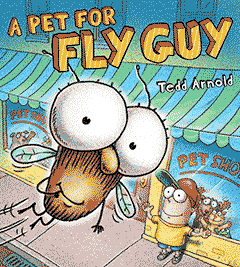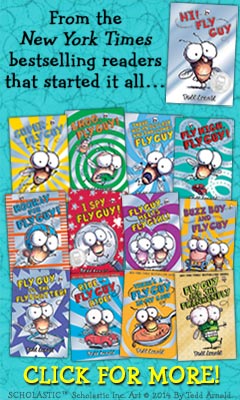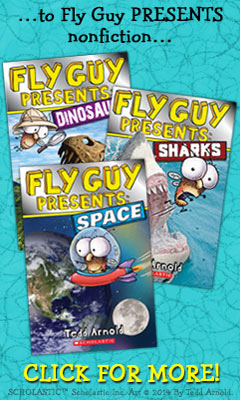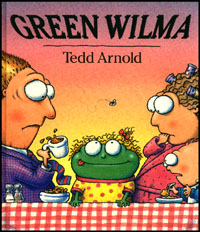A Pet for Fly Guy
by Tedd Arnold
Baseball cap–sporting Buzz and his best buddy, Fly Guy--an actual insect--star in this hilarious picture-book adventure, in which Buzz's pet fly searches for a pet of his own.
With just enough thought balloons to play up Fly Guy's clever communication capabilities, Tedd Arnold (Parts) conveys the strong bond between boy and fly. Buzz knows that Fly Guy is "the smartest pet in the world." He can even say the boy's name. One day, Buzz takes Fly Guy with him and his parents on a picnic. Readers can see Buzz's parents bringing up the rear with a picnic basket and checked tablecloth, but the author-artist carefully carves out a world that belongs solely to Buzz and Fly Guy.
Arnold's signature artwork, with its thick black outline filled in with silly string–like squiggles in pastel colors, can hardly contain the kinetic energy of boy and fly. He plays with perspective so Buzz and Fly Guy at times appear to burst from the page and approach readers directly. Children will savor Arnold's interplay between the text and illustrations. "They ate lunch," the text reads, as Buzz bites his sandwich and Fly Guy hovers over the trash. "They played together" accompanies an image of Buzz doing a handstand while Fly Guy balances on his heavily lidded eyes, anterior legs outstretched. One of the many treats of the book is how Buzz and Fly Guy entertain each other with their imaginations. "They looked at clouds" appears like a caption over cumulus happy faces and rocket ships, as Buzz points skyward and Fly Guy looks up from his perch at the top of a park bench.
Buzz treats Fly Guy like his bosom buddy, the way a child would a pet cat or dog. And so do the other people they observe, playing with their pets. One girl throws a life saver to a fish in a tank she's toting on her red wagon; a bear and blonde girl rock out to her portable radio; and a girl and her octopus relax in the park fountain. (Readers who proceed from this picture-book tale to Arnold's beginning readers will recognize some of the characters in the park as contestants in "The Amazing Pet Show" contest in his Theodor Geisel Award Honor book Hi, Fly Guy!) Arnold arranges these pairs on a spread as if they are rings in a circus, augmenting the comic effect. A boy and monkey hang upside-down from a tree; and one of the funniest duos involves a boy sporting a catcher's chest pad, heavy boots, thick gloves and a welder's shield to engage with his pet porcupine. Taking it all in, Buzz announces, "Wow!... Everyone has a pet." A sad-eyed Fly Guy announces in a speech balloon, "No Petz!" The author-artist reveals the insect's sorrow in a close-up view of Fly Guy's droopy wings and antennae.
Suddenly, Buzz has an idea! Up he pops onto the bench, "We will find a pet for you," the boy says. Fly Guy's antennae are up, he's flying to look Buzz in his big bulgy eyes, "Yezz?" Then Buzz plays parent: "But remember you have to take care of it." Fly Guy agrees to each command ("Yezz!"). Arnold makes the most of the farfetched situation, as Buzz comes out of the pet shop with a puppy: "It licked Fly Guy," the puppy's tongue sends the fellow topsy turvy. A cat swats at the winged hero, and a frog chases him.
"This isn't working," Buzz admits. "Only you can pick the best pet for you." Fly Guy leads them back to the park, where he finds a worm ("too slimy") and a spider ("too tangly"--Buzz has to rescue him from a web). In a fun send-up of the classic dogwalking scenerio, Fly Guy holds onto a leash-wearing cricket that's clearly in charge. Arnold paces the events just right. The moments of epiphany--when Buzz realizes that Fly Guy needs a pet, when he figures out the strategy is not working--get full-page treatment, which allows children to pause and take in the shift in the characters' thinking. The "auditions" for the pets occur in smaller inset scenes, to keep the plot moving. The frog and cricket chases move in a zig-zag across an otherwise white page, to play up the bouncy, out-of-control frenzy. The author-artist then returns to a full-page verdant scene in the park for Buzz's suggestion, "Let's think about this whole pet thing."
As Buzz lists the qualities Fly Guy needs in a friend, Fly Guy's thought balloons reveal that he may just know the ideal companion. Arnold's imagery leads picture-book readers along so they can guess Fly Guy's solution before Buzz does. We won't spoil it--let's just say Buzz and Fly Guy head off into the sunset with all matters resolved. This picture-book adventure packs in the humor while honoring the importance of giving friends room to try out new ideas and trusting that the friendship is strong enough to handle the prospect of change. --Jennifer M. Brown









 Some of the animals from "The Amazing Pet Show" in Hi, Fly Guy! wind up in the park where Buzz and Fly Guy go pet-watching in A Pet for Fly Guy. Did you have fun returning to them?
Some of the animals from "The Amazing Pet Show" in Hi, Fly Guy! wind up in the park where Buzz and Fly Guy go pet-watching in A Pet for Fly Guy. Did you have fun returning to them?  We've enjoyed your signature artwork, with its myriad squiggly lines embedded in each composition. Can you tell us how you arrived at this artistic style? It seems especially well suited to Buzz and Fly Guy, with their kinetic energy.
We've enjoyed your signature artwork, with its myriad squiggly lines embedded in each composition. Can you tell us how you arrived at this artistic style? It seems especially well suited to Buzz and Fly Guy, with their kinetic energy.